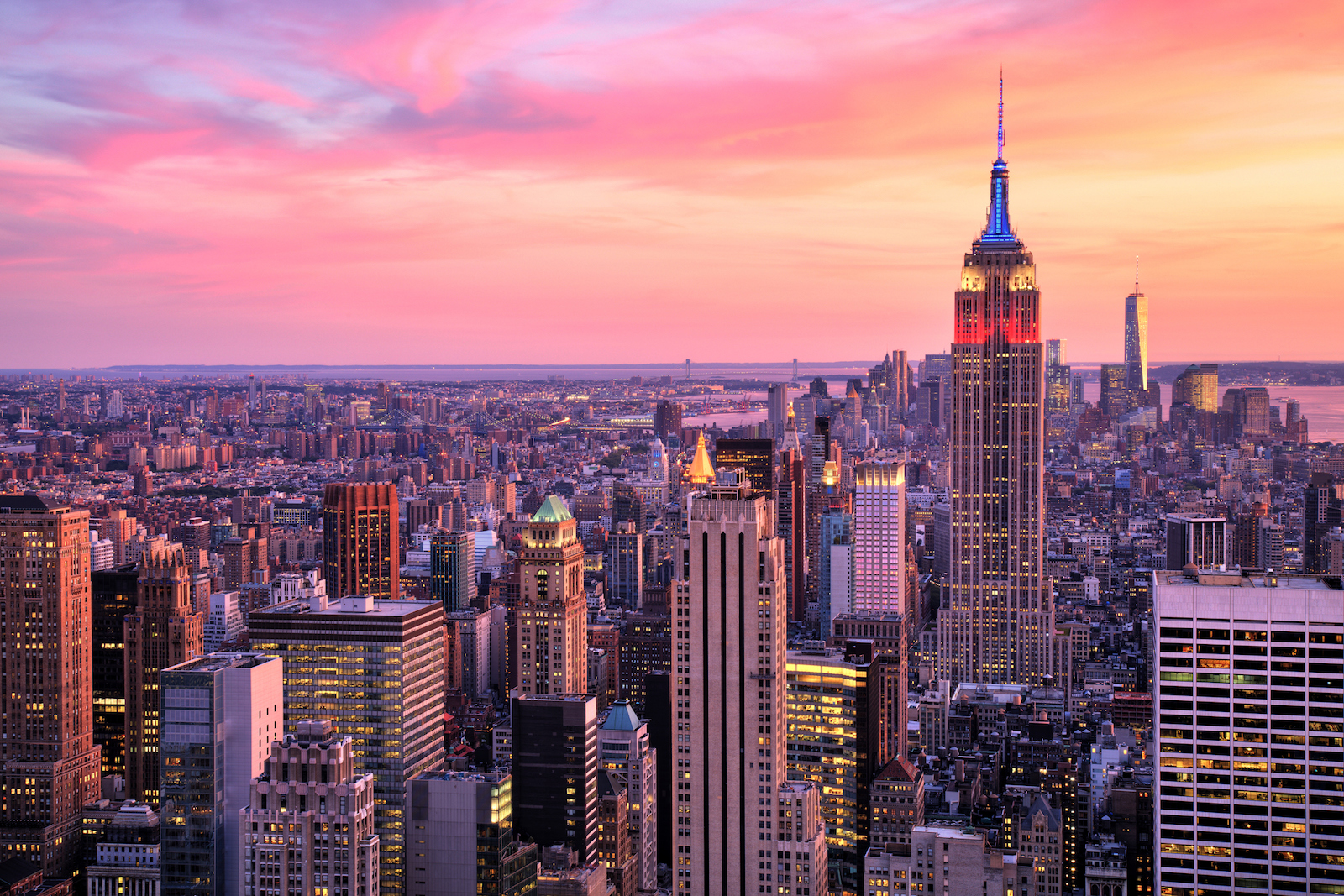Here are the 17 Surprising (but Totally True) Facts about NYC’s Most Iconic Building. It’s the best-known silhouette in New York’s skyline. But it’s also a trove of historical and cultural lore that most passersby never suspect. Whether you’re planning a visit or just cruising by, these are seventeen things we’ll bet you didn’t know about the Empire State Building.
- Despite its record-breaking size, construction took just fourteen months: The groundbreaking ceremony took place on March 17, 1930. 410 days later, on May 1, 1931, President Herbert Hoover flipped a switch to illuminate the building’s electric lights and declare it officially open for business.
- Its instantly recognizable shape was inspired by two earlier buildings. Architect William F. Lamb cribbed from his own work on the Reynolds Building in Winston-Salem, North Carolina; he also drew inspiration from the Art Deco design of the Carew Tower in Cincinnati. (Maybe that’s why it took him just two months to draft the plans.) His firm of Shreve, Lamb, and Harmon went on to design other projects including the Jerusalem International YMCA and the Uniroyal Giant Tire now located in Allen Park, Michigan.
- The construction crew employed up to 3,400 people at a time, including a group of famously fearless Mohawk Indian ironworkers. At its peak, the tower grew by an astonishing one story per day. Photographer Lewis Hine documented the process while perched precariously in a basket suspended 1000 feet above Fifth Avenue.
- To accommodate the furious pace of construction, new methods of transportation and organization had to be developed on-site. A miniature railway moved materials around the site eight times faster than they could be transported by hand.When it opened its doors, the Empire State Building had 6,400 windows and 6,700 radiators to provide its occupants with air and warmth. For the other necessities of life, it also boasted 2500 toilets and sinks connected by 51 miles of plumbing pipe.
- The building was a (relative) steal! Its original construction cost $40,948,400, or $533.6 million in today’s money — about $9 million under its original budget. By comparison, its major renovations completed in 2011 cost a total of $550 million.
- Completed just as the Great Depression was devastating the country financially, the Empire State Building struggled to fill its offices for its first few years. Its owners resorted to some unusual tactics to bring in paying tenants, including hosting a seance in 1932 that attempted to contact the ghost of Thomas Edison. (No word on whether or not the famed inventor showed up.)
- The biggest building in the world naturally needed one of its biggest monsters as a foil. King Kong first stormed the tower in 1933, and has been back in multiple film remakes and TV knockoffs since then. In 1983, a ten-story inflatable Kong made an in-the-flesh appearance at the tower as well, but bad weather and high winds soon rendered him more droopy than terrifying.
- Plenty of famous and infamous tenants have made the building its home over the years. Some big names include LinkedIn, Bulova, and outdoor advertising giant JCDecaux. A company called MetroNaps, which rented out futuristic soundproofed sleeping pods in twenty-minute chunks, occupied part of the 24th floor from 2004 to 2008.
- Going up? The 73 elevators take about one minute to travel from ground level to the 80th floor (where your wait for the observatory elevators can stretch for an hour or more during peak visiting times).
- Or, throw your name in the hat to join 499 other runners for the Annual Run-Up. The world’s first and longest-running tower race challenges participants to get from ground level to the 86th floor. It takes the fastest runners about 10 minutes to clear the 1,576 stairs (and a little longer than that to get their heart rates back to normal afterward).
- Over the decades since its construction, the ESB has survived natural disasters from earthquakes to ice storms. It even withstood an aerial assault in 1945, when a B-25 bomber pilot became disoriented in heavy fog and plowed into the 78th and 79th floors. Three crewmen and 11 people were killed in the accident, but one 19-year-old elevator operator was extra-lucky that day: Though the elevator car she was in plummeted to the ground when its cables were severed, she survived the 74-story fall and subsequent impact.
- The Empire State Building has seven full-service or quick-service restaurants at the lobby level, including its flagship STATE Bar and Grill. It’s also got a two-level Starbucks (but it’ll cost you $2 to get that flat white delivered to your desk).
- The Tower Lights are illuminated in different colors to commemorate a range of holidays and occasions, from classic Christmas red and green to yellow, purple, and gold for the Westminster Kennel Club Dog Show. STATE Bar and Grill offers a coordinating Empire State’wich: an ice cream sandwich whose colors match the nightly light show.
- The possibility of tumbling to your death isn’t enough to deter everyone from jumping off the observation deck. In 1998, two parachuters leapt over the rail and made it safely to the ground below. Since then, other BASE jumpers have tried to copy the stunt, despite robust security measures. In 2016, one repeat wannabe daredevil was slapped with a $350K lawsuit for his repeated trespassing.
- The 2011 renovations, dubbed The ReBuilding, both restored and transformed the building. Environmentally friendly additions included energy-efficient bulbs and ballasts that cut power bills by $4.4 million a year. But the centerpiece of the renovation took place in the lobby, with the removal of an unfortunate ‘60s-era dropped ceiling and the painstaking restoration of the original Machine Age ceiling mural.
- It was the tallest building in the world for 41 years; that’s longer than any other structure has held the record except for the Great Pyramid in Giza, Egypt (whose record of 3000+ years is likely to stand). One World Trade Center finally surpassed it in height when it was completed in 1972.
- Though it still serves its purpose as an office building, its status as a National Historic Landmark and one of the most recognizable structures in the world is critical to the Empire State Building’s bottom line. Financial disclosures from 2010 revealed that rent accounts for about half the building’s annual revenue, while the 4 million-plus paying visitors to the observatory bring in another 40 percent.




